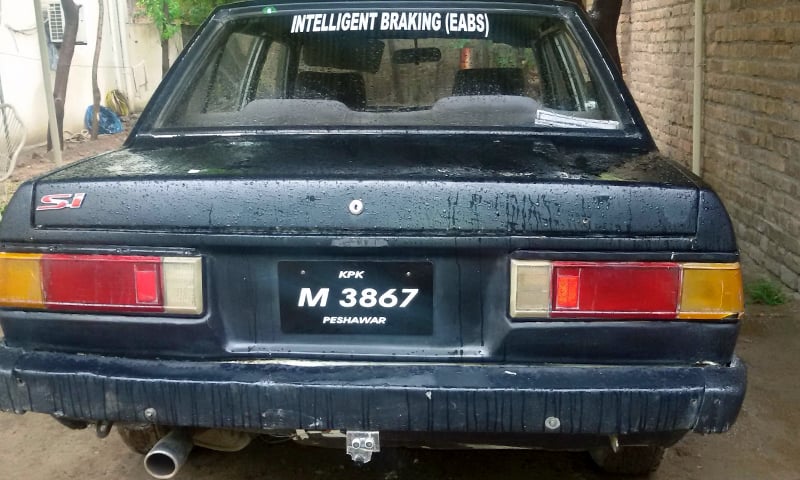PESHAWAR: Students in Peshawar’s engineering schools are solving a problem that could save countless lives: making vehicles safer to prevent road accidents.
Their solution involves installing an Autonomous Emergency Braking (AEB) system in a car, a mechanism which can be replicated in all vehicles.
AEB technology equips vehicles with the capability to brake automatically in troublesome situations; sensors alert the car or motorcycle in case it is about to hit an obstacle and the driver fails to respond in time.
An inspired idea
The idea draws on one earlier introduced in the United Kingdom where AEB systems were installed in a significant number of vehicles, resulting number of road accidents went down.
In Peshawar, students under the supervision of Professor Shahzad Anwar found this solution to be viable, and one they could replicate. They began studying AEB models, and have managed to build Pakistan’s first car equipped with an emergency braking system.

Rising road accidents
As far as road fatalities go, Pakistan ranks as the fifth deadliest country in the world for road fatalities, claims Zubair Hashmi, deputy inspector general of the motorway police.
Each year, more and more people are dying because of road accidents. The number has been on a steady rise; in 2013, a total of 5,271 died across Pakistan in reported road accidents, according to data available with Pakistan’s bureau of statistics.
As the rising death toll is becoming a matter of concern for many, Habibullah Bangash and his team of students have been busy doing something about it—their aim, through AEB systems, is to reduce these fatalities by 50 per cent.
Bangash, who hails from the tribal region of Hangu, says that road accidents mainly occur when drivers ignore traffic rules, are not skilled enough, or are distracted. A report that investigated the causes of road accidents in Pakistan found that 40 per cent of road accidents were due to ignorance of traffic rules, 32 per cent accidents were due to the driver’s distraction, and 28 per cent occurred because the driver was not skilled enough.


Why Autonomous Emergency Braking?
In 2015, the United Nations Economic Commission for Europe (UNECE) announced that the AEB system would be mandatory for all vehicles in order to reduce human casualties. Experts and centers working for vehicle consumers’ safety consider AEB to be among the best options for road safety.
Meanwhile, studies were discovering that the AEB systems had an unprecedented success rate. The Thatcham Research Centre (TRC) in the UK, which works to maintain the safety standards of UK’s vehicles, re-surveyed road accidents after the introduction of AEB systems in vehicles. They found that road accidents had reduced by 18 per cent. TRC’s study further suggested that fatalities could reduce by 27 per cent by 2025, if the technology was introduced in all vehicles.
Final-year engineering students in Peshawar began studying existing models of AEB, with the goal of implementing it in a local car.
How it works
The system requires the same basic parts, available in most city shops: two shuttle valves, two DC motors with driver modules, a separate master cylinder, four ultrasonic range finders, and a controller are the various parts required for an AEB system.

That might sound complicated, but the mechanism is fairly simple.
Three ultrasonic censors are fitted by the car’s headlights, and a fourth one is installed next to the headlights on the rear, to prevent collisions from the back.
These sensors monitor the movement of all kinds of physical obstacles and objects, including pedestrians, cycles, motorcycles and other vehicles. If the car detects an object it might be colliding into, an autonomous braking system comes into effect and the car stops three metres before the object of collision.
With a demo, Bangash explains that this autonomous system has no impact on the vehicle’s manual braking system. “They work in conjunction,” he says, “Users can also choose to switch off the entire system through a power button.”
Bangash motions to an emergency light fitted on a switchboard along with a buzzer. These, he demonstrates, go off to alarm the driver in case of an impending collision.
One of the best parts about the system is that it can be installed in both light travelling vehicles (LTVs) like cars and bikes, and high travelling vehicles (HTVs) like trucks and buses that run on the highway. The system is capable of stopping a vehicle travelling at the speed of 60km per hour, and it can kick in any time the manual braking system fails.

So far, Bangash claims there have been no complications after installing the AED system. “Local mechanics can install it on their own, as parts are available in the market,” he says, estimating the total cost of installation to be as low as Rs15,000.
































